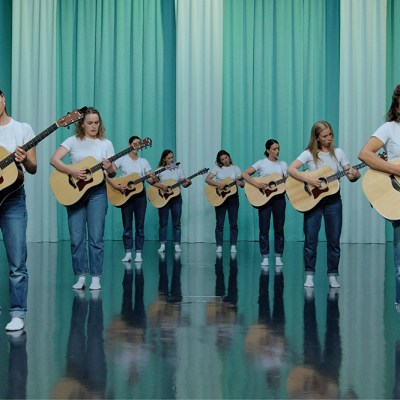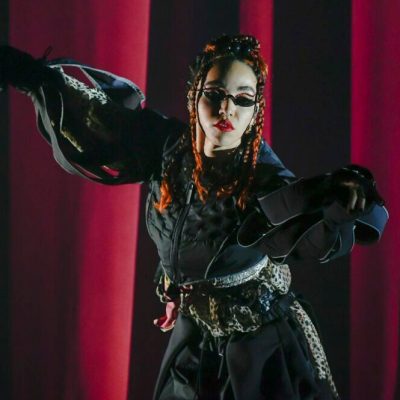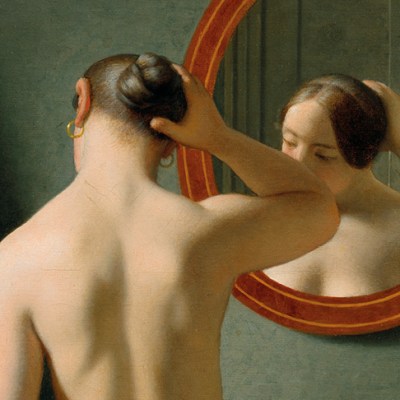From the June 2023 issue of Apollo. Preview and subscribe here.
I think we have wrapped up the interview but, in spite of the salty rain coming off the North Atlantic, Ragnar Kjartansson insists on giving me a tour of his hometown. ‘It’s really like a village here,’ he says as we climb the hill leading into town from Reykjavik’s docks, and I soon see what he means. Within 90 seconds, Kjartansson has been flagged down by two men on the street. He indicates that I don’t know Icelandic, and everyone switches to English. One man gesticulates towards a weathered old Defender parked on the curb. ‘That’s my car!’ exclaims Kjartansson, who these days mostly gets around town on an electric scooter. ‘I sold it to him! How is she?’ The car runs fine, apparently, but it smells bad, the roof leaks.
Everyone collapses into laughter and trades a few back-slaps. And then we’re on our way again, up Ægisgata towards the Catholic cathedral, where Kjartansson volunteered as an altar boy. (He was brought up Protestant but, given how few Catholics there were at the time, nobody was in a position to be picky.) The imposing structure combines Gothic Revival with trappings of an art deco vernacular largely dreamed up by its architect, Gudjon Samuelsson (1887–1950). In the years before the country became an independent republic in 1944, Samuelsson became its state architect, although it has clearly taken more than one master builder to forge a concrete sense of Icelandic-ness. ‘I remember it so well when my parents and my grandparents’ generation were all about creating an identity for this country,’ Kjartansson told me earlier.
The Reykjavik where he grew up in the 1980s was, he says, ‘pretty bleak. It really felt like this place at the end of the world, and you were like, “Wow, wouldn’t it be cool to be a proper country?” It was a land with an inferiority complex [but it had] a kind of megalomania.’ Born to actor parents in 1976, over the course of his lifetime Kjartansson has seen Iceland transition from Arctic Circle backwater to Nordic arts powerhouse.
Still from The Visitors (2012), Ragnar Kjartansson. Commissioned by the Migros Museum für Gegenwartskunst, Zurich. Photo: Elísabet Davids; courtesy the artist, Luhring Augustine, New York and i8 Gallery, Reykjavik; © Ragnar Kjartansson
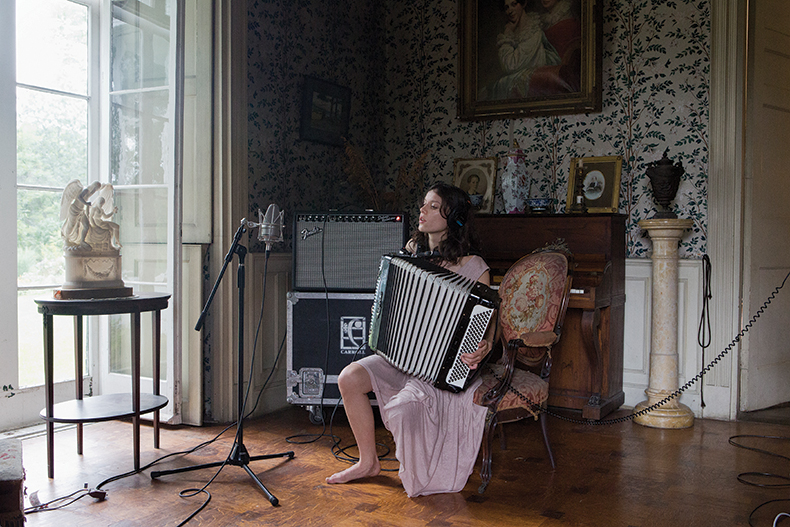
While he would be too modest to say it, Iceland’s current cultural heft owes more than a little to Kjartansson himself. The advance publicity for his retrospective at the Barbican Art Gallery and Hirshhorn Museum in 2016, for instance, styled him as ‘the world’s finest performance artist’ and, hyperbolic as that statement may seem, even normally sceptical reviewers seemed to concur. It was no one-off. Towards the end of 2019, the Guardian chose his multi-channel video work The Visitors (2012) as the century’s most outstanding work of art to date.
The defining mood of 21st-century art has been doomy, forbidding and often imbued with cynicism: think of Anne Imhof’s efforts to identify links between fascism and the built environment, or Arthur Jafa’s pessimistic meditations on race relations. The Visitors, by contrast, is wistful, romantic and uncommonly sincere. It confronts the viewer with nine tall screens, one of which lights up to display a film of a life-sized Kjartansson strumming a guitar in the bathtub of a grand but rather dilapidated house. Over and over again, he repeats the refrain of a song written by his ex-wife, Asdis Sif Gunnarsdottir: ‘Once again, I fall into my feminine ways’. The other screens light up one after another to reveal friends in adjacent rooms playing along to the tune with different instruments, repeating the same chorus but gradually building the song up to an epic crescendo. They eventually congregate on the same screen to stroll out into the garden, where they pop the cork on a bottle of champagne and disappear into an upstate New York landscape that could have been painted by Thomas Cole.
Still from The Visitors (2012), Ragnar Kjartansson. Commissioned by the Migros Museum für Gegenwartskunst, Zurich. Photo: Elísabet Davids; courtesy the artist, Luhring Augustine, New York and i8 Gallery, Reykjavik; © Ragnar Kjartansson
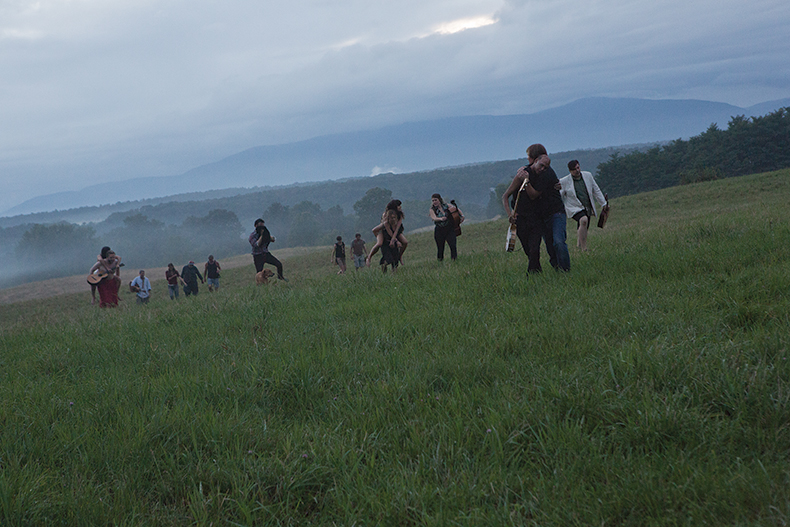
The piece is typical of Kjartansson’s output, combining the framework of 1970s durational performance art with hints of 19th-century Romanticism and elements borrowed from theatre, comedy, advertising, cinema and his first love, pop music. ‘I remember very much like being blown away by hardcore performance art, especially feminist performance art,’ Kjartansson says of his formative influences. ‘Some of this stuff, it might almost seem kitsch today, but when they were doing it, it was like, BOM! Fucking identity. And the hardcore performances of Marina Abramovic and of Chris Burden, just blew me out of the water. I remember being so inspired by this, but thinking, I cannot just copy that […] So I think it just seeped into me to do work that was sort of inspired by this ’70s approach, but also had this kind of “ta-dah!”, theatrical aspect to it. That it was presented as light entertainment, I thought was an interesting twist.’
Our earlier ‘official’ meeting takes place at Kjartansson’s studio on the wharf, a lot in a neat line of little bunkers built as repair shops for the boats of the Icelandic fishing fleet. The docks are just metres away: from here, you can see both the almost Alp-sized mountains of Videy island, as well as the immense fishing vessels that replaced the models these structures were built to service. As the artist puts it: ‘Whale-watching tourist boats, right next to whale-killing ships. Ha!’
Dope and Corruption (2017), Ragnar Kjartansson. Courtesy the artist, Luhring Augustine, New York and i8 Gallery, Reykjavik; © Ragnar Kjartansson
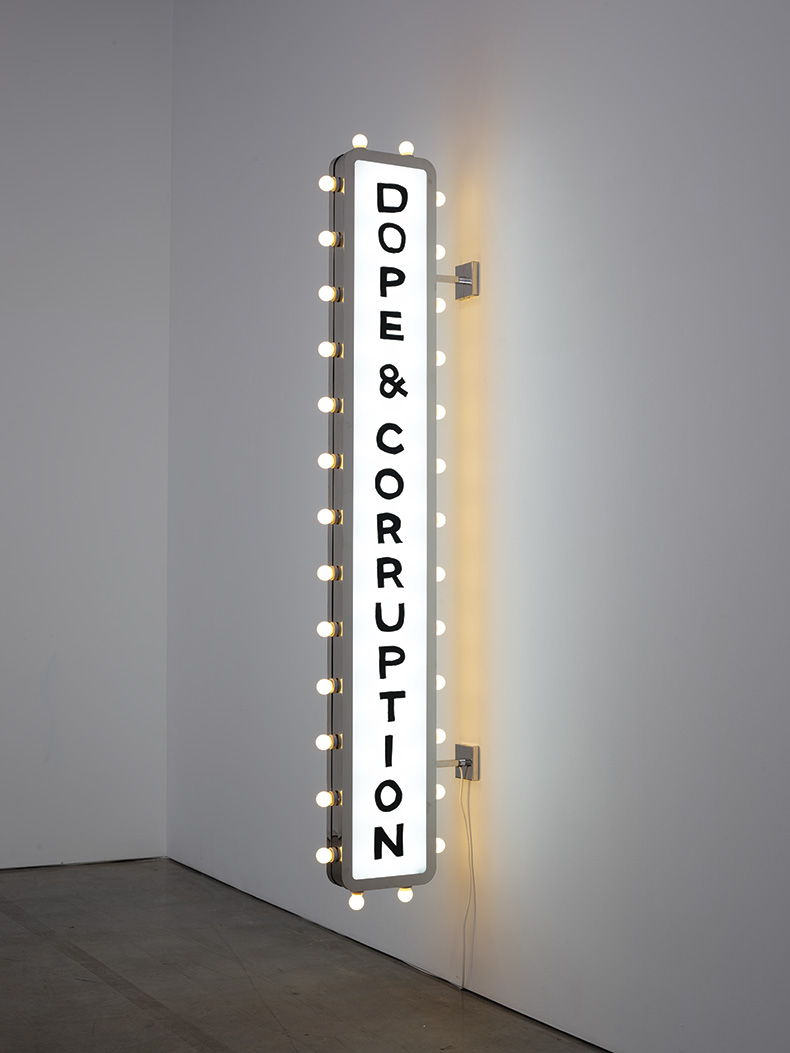
About a quarter of the studio is given over to an almost domestic arrangement, including a kitchenette, part of the artist’s voluminous record collection and several works by local artists. There are also some examples of Kjartansson’s own handiwork, notably an artist’s proof of the piece Dope and Corruption, an illuminated sign for a pop-up strip club he opened at a Danish music festival in 2017. (Kjartansson was doing the pole-dancing.) He is deep into preparations for ‘Epic Waste of Love and Understanding’, his retrospective at the Louisiana Museum of Modern Art in Denmark (9 June–22 October).
The title of the show is one of many open-ended epithets dreamed up by Kjartansson’s wife, the artist Ingibjorg Sigurjonsdottir, who is one of his regular collaborators. On the wall is a preparatory drawing for an immense triumphal column inscribed with the exhibition title that will greet visitors to the museum. Kjartansson shows me a photo of the wooden ‘eternal flame’ that will sit atop it. ‘It’s not too 2D?’ asks his assistant Lilja Gunnarsdottir. ‘No! It’s beautiful, amazing!’
On an easel there is a painting of the country singer George Jones belting out a song. Kjartansson has added a not-entirely-flattering likeness of himself peeping in through the window behind. Though his projects are always realised with the help of others – ‘I really like a very social situation’, he says – he has always managed to make his own presence felt in his work, whether through literal self-portraiture, or via more imaginative means. Take, for example, the performance Take Me Here by the Dishwasher: Memorial for a Marriage (2011), which featured, inter alia, ten guitarists lying on mattresses singing a song about the artist’s conception.
Installation view at the Barbican Art Gallery, London, of Take Me Here by the Dishwasher: Memorial for Marriage (2011–14), Ragnar Kjartansson, performance installation with music by Kjartan Sveinsson featuring ten troubadours and an excerpt from the film Mordsaga. Photo: Tristan Fewings; courtesy the artist, Luhring Augustine, New York and i8 Gallery, Reykjavik; © Ragnar Kjartansson
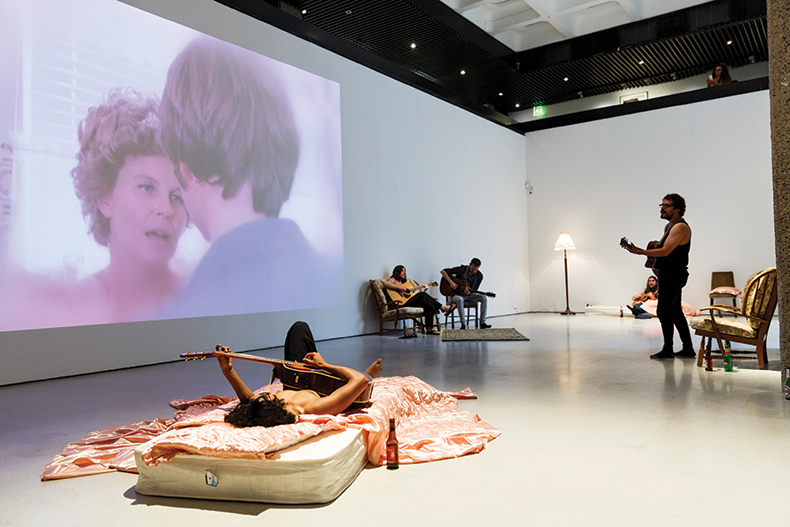
Often enough, Kjartansson throws himself into a situation in a way that could be considered reckless, if not downright daft. There was the ‘batshit situation’, in 2016, when he decided to go and paint Israeli settlements on the West Bank, styling himself as a plein-air painter complete with Van Gogh-esque straw hat (‘Well – you really need it in the sun.’) More recently, in December 2021, he staged the inaugural exhibition at Moscow’s GES-2, ‘about the Western aspirations of modern Russia’, for which he attempted to re-enact some 100 episodes of the American soap opera Santa Barbara using Russian and Ukrainian actors who had grown up watching it. The spectacle around the show’s planning and installation was filmed by Gaukur Ulfarsson, who has since edited it into a documentary.
The show was the first US series broadcast in the former USSR. It probably did much to shape what happened thereafter: ‘I thought of Santa Barbara as this huge-scale history painting,’ Kjartansson explains. ‘It was kind of a cultural war painting, about the West conquering Russia. Little did I know what was going to happen.’ On 24 February 2022, two weeks before the end of the show’s run, he woke up to find that the last vestiges of the ‘modern Russia’ in which he had immersed himself had disappeared overnight. ‘The first thing I do is to call the museum and say, “We have to close, we cannot keep the show open now”.’ He has no plans to display Santa Barbara in the near future. ‘Now is not the right time to show it both for artistic reasons and out of respect for Ukrainians who are defending their freedom from those murderous empire dreams,’ he later explains via email.
One of Kjartansson’s first significant projects was Death and the Children (2002), a strange short monochrome video in which we see a group of schoolchildren being guided through Reykjavik’s main cemetery. As they pass a bunker-like tomb, a heavily kohled-up Kjartansson springs from its door in black tie, waving a comedically fake prop scythe. ‘I AM DEATH!’ he yells. The children are sceptical. ‘[My scythe] might look paper, but it is the scythe of DEATH!’ he counters when they point out how unconvincing it is.
On our impromptu sightseeing tour, we walk past that same tomb, and Kjartansson stops to demonstrate the spooky, horror-movie sound effect conjured by rapping on its door. The noise is still echoing as we approach the final resting places of Iceland’s seemingly innumerable national poets. ‘That’s the great thing about not having a military here,’ he says. ‘We don’t have monuments to generals, or whatever. We have poets.’ Pride of place, however, is taken by the tomb of Jon Sigurdsson, the 19th-century politician who put Iceland on the path to independence.
Given the historical relationship with Denmark, I wonder how crass it is to ask whether, for an Icelander, mounting a major exhibition in the former metropole comes with emotional complications. ‘No, it’s not complex… it’s really just tremendously exciting, sort of a dream come true I’d say,’ Kjartansson says. Nevertheless, he adds, ‘it’s weird. There’s still a sense that Copenhagen is the capital, it’s still like we feel we’re a… fief.’ He tells me that his 87-year-old mother is so overwhelmed with pride that she has abandoned a resolution to stop travelling in order to come to the opening at the Louisiana.
Performance shot of The End – Venezia (2009), Ragnar Kjartansson. Commissioned by the Center for Icelandic Art. Photo: Rafael Pinho; courtesy the artist, Luhring Augustine, New York and i8 Gallery, Reykjavik; © Ragnar Kjartansson

It’s not as if the relationship between colony and metropole hasn’t been a source for material. ‘Just after art school, I was super drunk at a bar in Copenhagen, and I was just being an asshole,’ Kjartansson recalls. ‘I kicked the door and broke the glass in it, and then the doorman got me down and I was sent to the jail in Copenhagen. But instead of being ashamed of myself, instead of being, like, “what have I done?”, I immediately went into post-colonial mode, shouting “THIS IS WHAT YOU DID TO MY FOREFATHERS!”’
In 2003, Kjartansson was invited to take part in a small group show called ‘Iceland and Denmark’, and found himself revisiting the incident. ‘I made this piece [Colonization, 2003] which was shot on a creative little stage set, where I am an Icelandic peasant being beaten up by a Danish noblemen. It’s very much this kind of vaudeville thing where I’m being, you know, drowned in water, beaten with a whip, then in-between all this, there were scenes of Copenhagen being drenched in blood.’ It will, he says, be brought out of retirement for the Louisiana show – and he’s interested to see how it is received.
Ragnar Kjartansson photographed in his studio in Reykjavik in May 2023. Photo: Lilja Birgisdottir
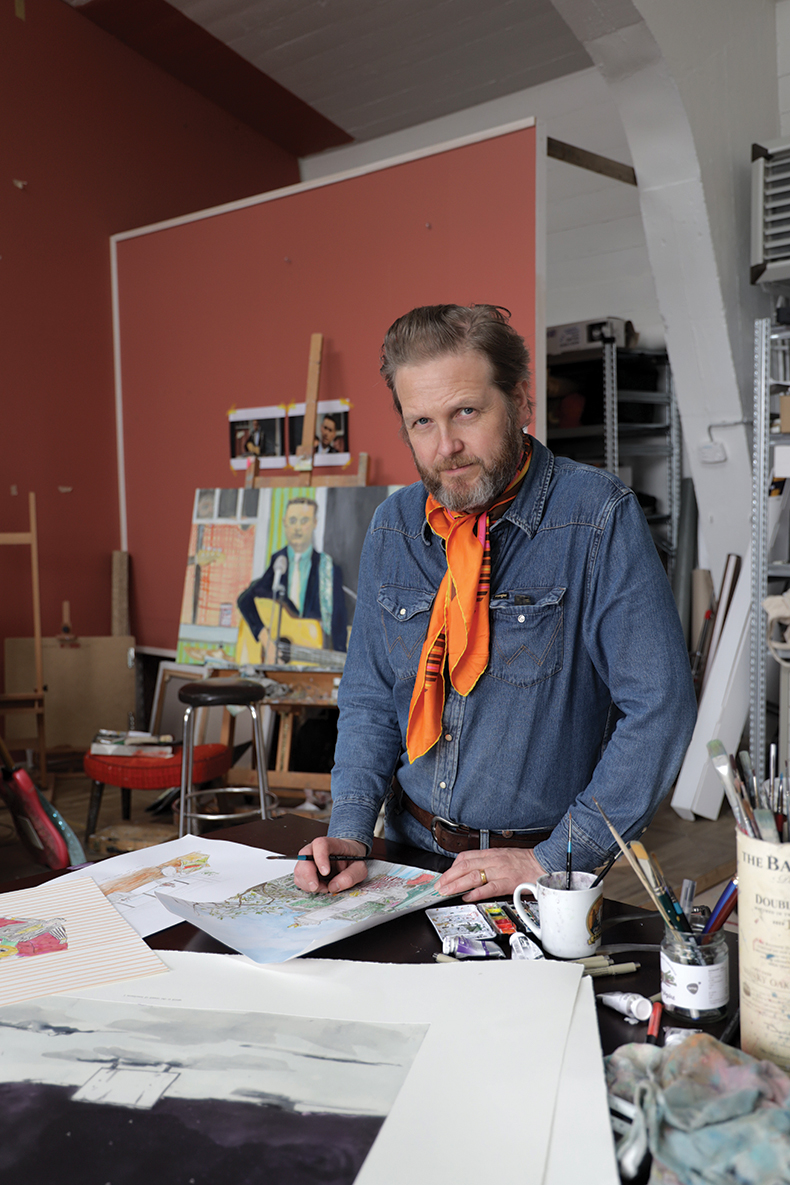
‘Icelanders really identify as colonial victims,’ Kjartansson says. And while terrible things happened to ordinary Icelandic people during the colonial era, there are, he says, ‘letters where the Danish colonial rulers were telling these landowners to remember that people are humans and treat them with humanity. Iceland’s nationality is so much based on being victims of the Danes. Well, maaaaybe… we weren’t.’
‘We have a Calder here,’ Kjartansson says, as we brave the rain from the cemetery to the city’s main park. ‘Just not by the right Calder.’ He’s referring to the immense statue of Leif Eriksson outside the Hallgrimskirkja church, given by the United States and sculpted by Alexander Stirling, Calder père.
Public sculpture is not Reykjavik’s main selling point, but Ragnar Kjartansson could probably convince you otherwise. Continuing from the cemetery down to the town pond, he gives me a potted history of the local form since the mid 19th century. At one point, we see Einar Jonsson’s ludicrous effigy of a burly man with a dog at his feet carrying the corpse of a beautiful woman in one arm, a child in the other. It is intended to represent the importance of the outlaw in Icelandic society – a stock archetype forged in the sagas written here between the ninth and 11th centuries (or so Kjartansson tells me).
Beyond Iceland’s farmhouse-sized parliament building, Kjartansson indicates an effigy of the sculptor Bertel Thorvaldsen (1770–1844), a gift to Reykjavik from the Danish state. ‘He was half-Icelandic, and he was always very happy about his roots. He was kind of the first artist to come by here. You can imagine him arriving from a ship, in the mud, in the 1840s.’ Perhaps the arts have always been central to Iceland’s identity: after Thorvaldsen’s death, his sculpture was placed slap bang in the middle of the Austurvöllur, Reykjavik’s main square; it was only moved in 1944, Kjartansson says, to make way for a likeness of Jon Sigurdsson.
Sigurdsson is venerated for good reason. ‘Jon Sigurdsson was not a nationalist, he was basically a lawyer who was very interested in good government,’ Kjartansson says. ‘He made the point that Iceland had to be self-governed, and his point was that Iceland should govern itself as a democracy […] It was very un-revolutionary, which was even better because it didn’t happen in blood. It shows a lot of good faith from the Danes that they listened and said, well – that’s a good point.’
Kjartansson exhibits something of this eminently reasonable attitude, particularly when it comes to the so-called culture wars. ‘Back in the ‘90s, you just had to, like, fuck a goat, to try to make something “shocking”. But now it’s really a kick, to make art in a complex context, and to have this tension around that. So it’s a luxury situation to work in the 21st century, where everything is being deconstructed constantly.’
‘What I love about being from Iceland,’ Kjartansson says, ‘is that I really did not understand the idea of the art object until I was 35 or something. Like, you go to the museum here and you just see some Icelandic shit… there is no art history, and there are no objects of mega-value.’ We have been discussing the boom and bust of the NFT bubble, but it’s a statement that might be key to understanding Ragnar Kjartansson’s attitude to making art. On the one hand, there is the more theatrical side of his work, which despite often requiring elaborate stage sets and weeks of rehearsals, leaves little in the way of a physical footprint. On the other, there’s painting, a discipline he approaches with slapdash enthusiasm. Lovely as his pictures often are, he seldom places much value on them as physical objects. Instead, they are mementos of durational constraint.
Performance shot of The End – Venezia (2009), Ragnar Kjartansson. Commissioned by the Center for Icelandic Art. Photo: Rafael Pinho; courtesy the artist, Luhring Augustine, New York and i8 Gallery, Reykjavik; © Ragnar Kjartansson
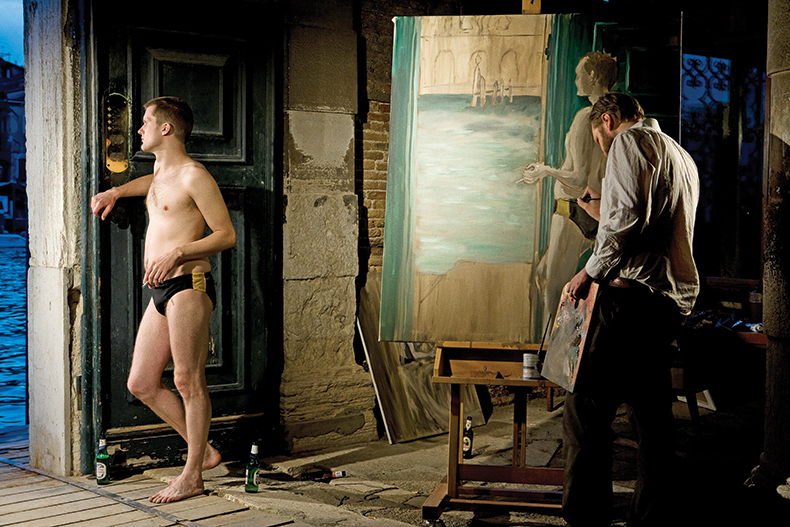
At the Venice Biennale in 2009, for instance, he and his friend Pall Haukur Bjornsson set up shop in a room by the Grand Canal to realise a project called The End – Venezia. Kjartansson undertook to make a new painting of the Speedo-clad Bjornsson every day, recording the mountains of beer bottles and cigarette butts that built up over the course of the 144 days of the performance. Bjornsson later recalled that when the room would periodically flood, completed paintings would fall from the walls and float around in the filthy water. ‘I really love to paint outside,’ Kjartansson says of this approach. ‘And I love the idea that when you’re doing it, you have to get it done – it’s like cleaning a room.’
We part at the art deco Hotel Holt, the distinctive pink sign of which was the basis for his neon work Scandinavian Pain (2006–12). There is one last surprise in store, perhaps a corrective to the idea of Icelandic art history being sparse: in the lounge of the hotel’s bar hangs a miscellany of portraits by the local artist Johannes Kjarval (1885–1972). ‘Roni Horn says it’s the best portrait room in Europe,’ Kjartansson says. Horn, a regular visitor to Iceland since the 1970s, who wrote a book about the country, may well be right: it’s a bizarre menagerie of bulbous noses, bulging eyeballs and just a couple of likenesses striving for, but not quite attaining, cosmopolitan elegance.
The following day, at Keflavik airport, I’m reminded of something Kjartansson tells me about, as he puts it, ‘coming home to the end of the world’. He says that because he knows he always has to come back to Iceland, he never feels ‘jaded’ about the art world, that it remains an unfailing source of excitement. ‘The idea of travelling over the ocean and then coming to this, it’s like a line of a poet about coming home on a ship in the ’50s: “Somewhere among all this rock, I live.” I really like that line. So… among these rocks I live.’
‘Epic Waste of Love and Understanding’ is at the Louisiana Museum of Modern Art, Humlebæk, from 9 June to 22 October.
From the June 2023 issue of Apollo. Preview and subscribe here.

